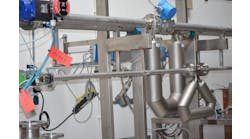A differential pressure (DP) application had capillaries—small-bore armored tubing connecting the remote seal to the transmitter—in excess of 50 feet. When the weather turned cold, there was enough of a viscosity change in the fill fluid to cause a time lag in the longer leg, making an otherwise quiescent measurement extremely noisy. If this had been "real" DP instability, it could have meant death and destruction for the millions of dollars of precious metal catalyst in the reactor, so it caused more than a little trepidation—until we figured out the correlation with cold weather.
Twenty years ago, a lot of end users became enamored with remote seals as an alternative to wet-leg DP level and DP flow applications. Using DP for level has its appeal: one gains some commonality or uniformity of spare parts with flow and pressure applications, calibration standards and procedures are similar, and service is uncomplicated compared with external-cage methods. But wet legs are a challenge when the fluid filling the impulse lines (the tubing connecting the DP transmitter to the level taps) is prone to freezing, polymerization or plugging of other kinds. And since the DP measurement is in effect "weighing" the head of the liquid above each tap, undetected changes in density or specific gravity will cause an offset or error in the level measurement, as will gradual vaporization of fill fluid in the wet leg.
Remote-seal DP transmitters for level address a number of the pitfalls of conventional wet-leg applications. Only the vessel nozzle and the isolation valve to which the seal connects are vulnerable to freezing and plugging, and they benefit from the conducted heat of the process itself. The fluid in the wet legs is purged free of any vapor pockets, 100% filled with a synthetic oil, and sealed with high-integrity welds. This isolation also makes them appealing for high-pressure, corrosive or toxic applications where we prefer that the instrument tech isn't exposed to the hazards. But since such systems are sealed, they impede everyday DP transmitter calibration and spare parts procedures. Frequently a dedicated spare is needed for each application. Even though these properties caused the price to be double a normal DP level transmitter, we specified quite a few of them.
When the measurement is differential pressure, whether direct (DP) or indirect (level), why not just use two pressure transmitters and take the difference? The problem is, the difference we aim to measure is often a minute fraction of the system's static pressure. In the case of our reactor, the static pressure is nearly 5,000 psi, and the DP of interest had a full scale of around 100 psi. If you happen to find a transmitter with an upper range value (URV) of 5,000 psig, the full scale of the DP measurement is 2% of span. A change of one or two pounds was meaningful, which translates to 0.02% of span. As Profibus expert and author James Powell pointed out in a November 2015 posting on the "Profinews" website the uncertainty of 4-20 mA analog is degraded even further when the configured span is a fraction of the transmitter's capability.
We thought we might have to heat trace the capillaries. Fortunately, we had digitally integrated (fieldbus) transmitters.
Today, the reactor DP and a dozen other DP and level measurements have been converted from DP transmitters to "DP by difference" using two static pressure transmitters. It works because the transmitters communicate digitally, and carry a tighter spec and warranty for accuracy and stability right out of the box. It costs more—you're buying two transmitters instead of one—but the method has become the standard whenever precision and reliability is critical. If you're measuring several DPs across a tower or reactor, you only need N+1 transmitters (for example, three to measure two DPs), so the cost difference is less.
If you're using a legacy platform, you can get the approximate performance by using any of the much-lauded "electronic remote seals" offered by Emerson Process Management, or similar products from Endress+Hauser and Vega. Similar to our method, the difference is computed digitally in the transmitter, but sent to the system as 4-20 mA. You won't find a Profibus or Foundation fieldbus version of these products, because the precision required is already there.





